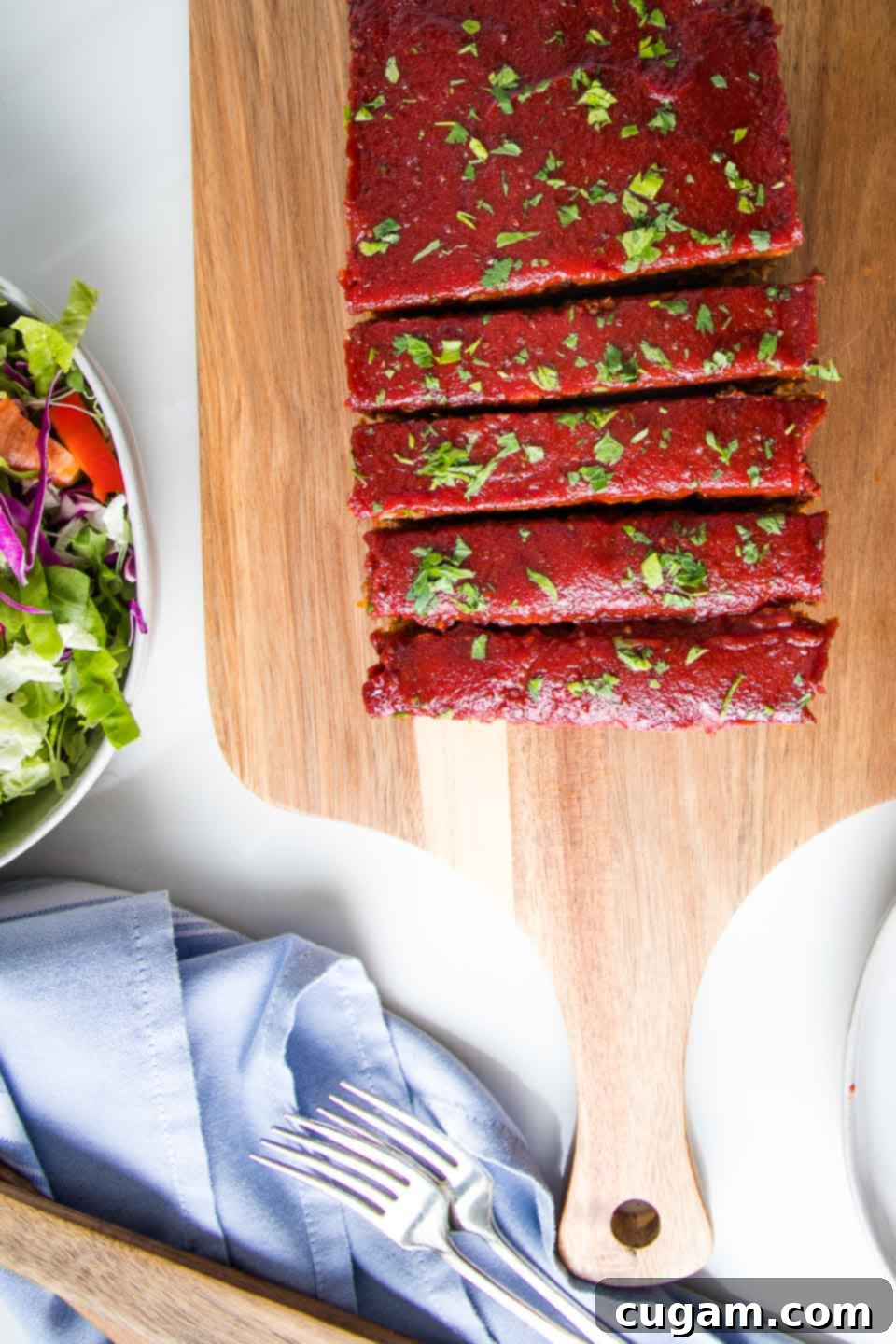Homemade Vegan Meatloaf: The Best Plant-Based Recipe for Healthy Comfort Food
Craving a classic comfort dish but looking for a healthier, plant-based alternative? Look no further! This incredible vegan meatloaf recipe delivers all the rich, savory flavors and satisfying texture of traditional meatloaf, without any of the meat. It’s truly a game-changer for anyone seeking a wholesome, hearty meal that tastes absolutely amazing. Forget bland or dry imitations; this plant-based meatloaf is moist, flavorful, and incredibly satisfying – a true triumph of healthy comfort food.
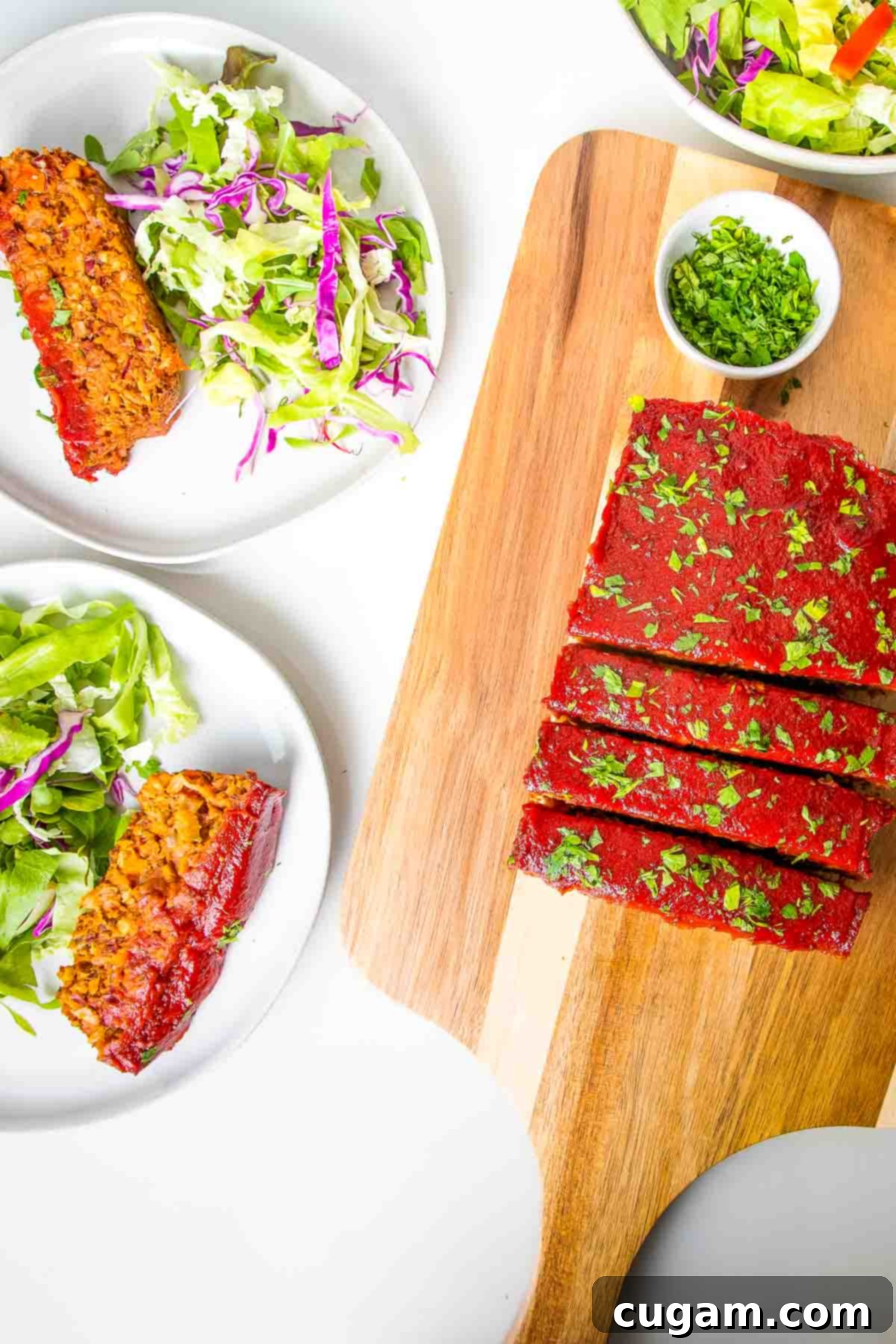
Are you one of the many who’ve been on a quest for the perfect vegan meatloaf recipe? It’s a surprisingly common request, especially as the seasons change and the desire for cozy, nourishing meals grows. As the weather cools, our bodies often signal a yearning for comforting dishes, and for those embracing a plant-based lifestyle, a healthy meatloaf is high on the list. I understand that longing for a dish that feels like a warm hug, and I’m thrilled to share a recipe that fulfills that desire with wholesome, clean ingredients.
This recipe isn’t just a substitute; it’s a celebration of plant-based goodness, offering a delicious and nutritious twist on a beloved classic. It’s designed to be simple to make, ensuring that even on a busy weeknight, you can whip up a batch of this delightful meatless meatloaf. For the ultimate nostalgic meal, pair it with a generous serving of creamy vegan mashed potatoes, and you’ll instantly transport yourself back to the comforting flavors of childhood, all while enjoying a meal that’s truly good for you.
Key Ingredients and Smart Substitutions for Your Vegan Meatloaf
Crafting the perfect vegan meatloaf begins with a thoughtful selection of ingredients that build both flavor and structure. This recipe focuses on whole, natural components to create a dish that’s not only delicious but also incredibly nutritious. Here’s a detailed look at what makes our plant-based meatloaf so special, along with flexible substitutions to suit your pantry and preferences:
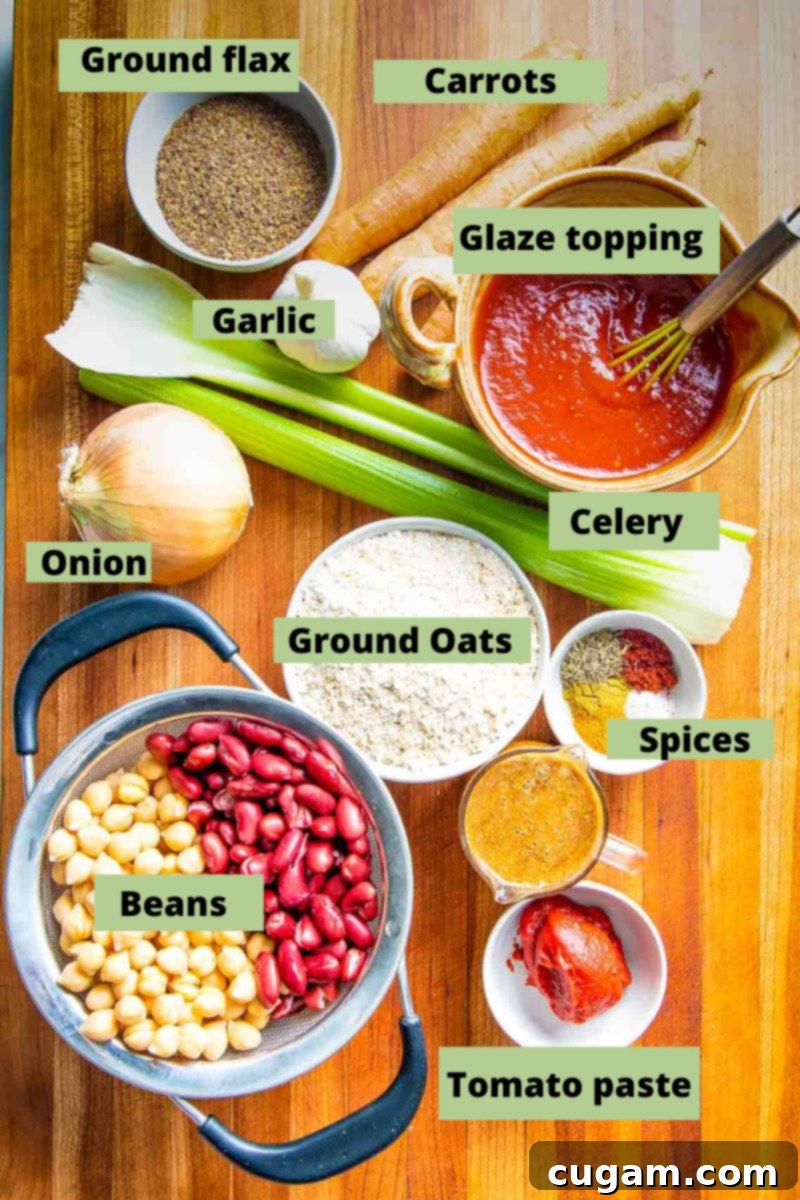
- Mashed Beans: These are the true heroes of our vegan meatloaf, providing the essential structure, a rich source of plant-based protein, and abundant fiber. I’ve found that a combination of kidney beans and chickpeas offers the best color and texture, closely mimicking traditional ground meat. However, this recipe is highly adaptable! Feel free to use any mix of beans you have on hand, such as pinto beans, cannellini beans, or great northern beans. Cooked lentils also work wonderfully for a slightly different, but equally delicious, texture. The key is to mash them sufficiently to bind, while leaving some small chunks for a more varied bite.
- Aromatic Veggies: Sautéed onions, carrots, and celery form the classic flavor base, infusing the meatloaf with a deep, savory aroma. These vegetables are cooked with a blend of traditional meatloaf spices, creating a robust and comforting profile. For a twist, you can experiment with other root vegetables or aromatics like leeks, parsnips, or even finely chopped fennel to add a unique layer of flavor. Ensure they are finely diced for even distribution and a cohesive texture.
- Ground Oats and Ground Flaxseed: These two powerhouse ingredients are crucial for binding the meatloaf together, ensuring it holds its shape perfectly without drying out. Both are naturally gluten-free, making this recipe accessible to more diners. Ground oats (simply oats blended into a flour-like consistency) provide a hearty, substantial binder, while ground flax seeds act as an excellent egg substitute and contribute healthy omega-3 fatty acids and additional fiber. Together, they create a wonderfully firm yet moist texture.
- Moisture & Umami Boosters (Tamari, Almond Milk, Vegan Worcestershire Sauce): To prevent our vegan meatloaf from becoming dry, a trio of liquids is used to impart moisture and a depth of savory, umami flavor. Tamari, a gluten-free alternative to soy sauce, adds salinity and richness. Almond milk (or any other neutral-flavored plant-based milk like soy or oat milk for those with nut allergies) provides creaminess and helps achieve the desired consistency. Vegan Worcestershire sauce is a secret weapon, delivering a tangy, complex savoriness that is often found in classic meatloaf recipes. Opt for low-sodium tamari if you’re managing salt intake.
- Tangy Glaze Topping: This is arguably my favorite part of any meatloaf! Our homemade glaze is a vibrant combination of tomato paste, apple cider vinegar, and coarse whole-grain mustard, balanced with a touch of maple syrup. This mixture bakes into a glossy, sweet-and-sour topping that adds an irresistible tang and moisture to every slice. The acidity from the apple cider vinegar cuts through the richness of the meatloaf, while the mustard provides a pleasant warmth and depth.
Why You’ll Fall in Love with This Vegan Meatloaf
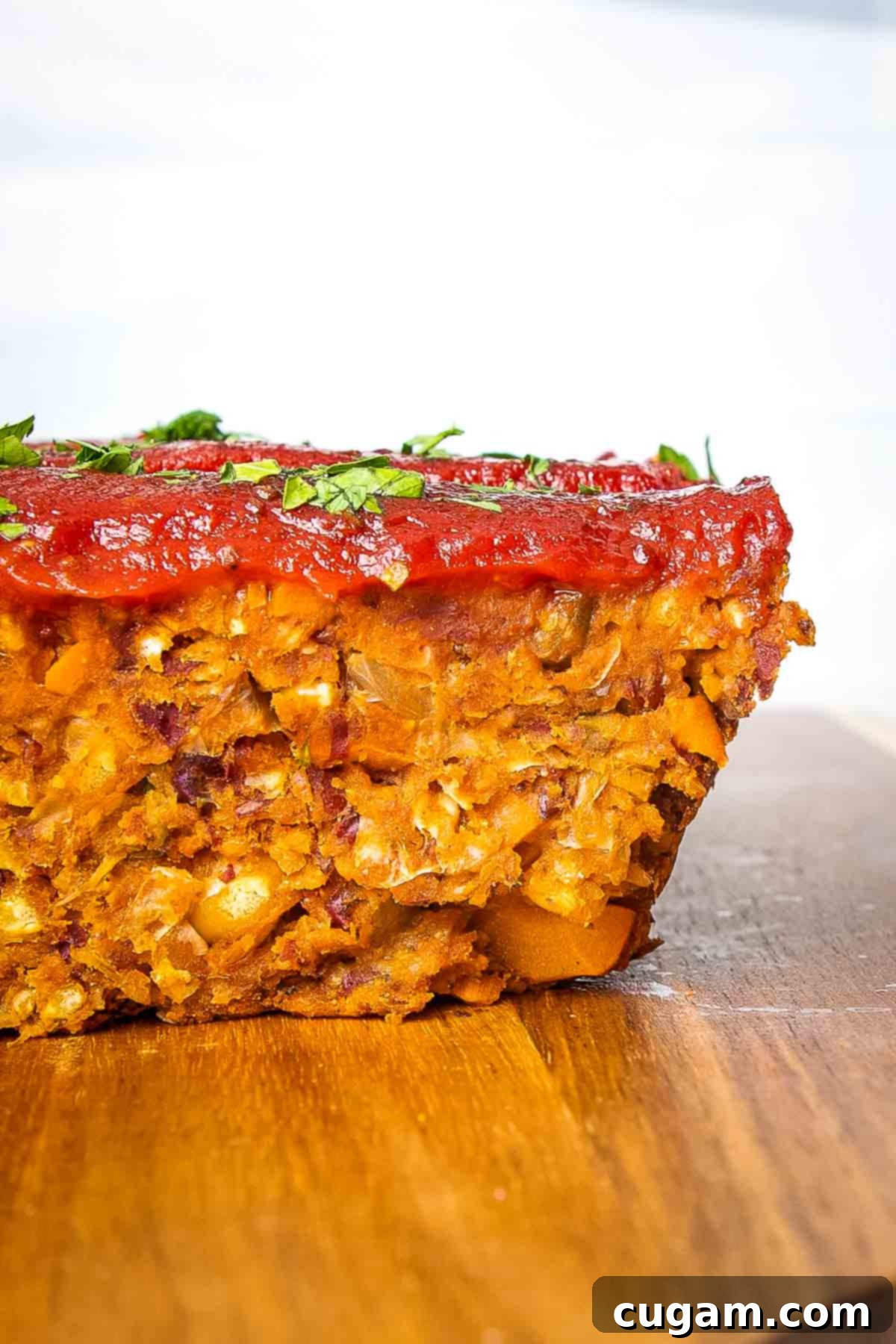
This isn’t just another vegan recipe; it’s a culinary experience designed to impress even the most skeptical palates. Here’s why this plant-based meatloaf is destined to become a staple in your kitchen:
- Unforgettable Flavor: Every bite bursts with savory, earthy notes, perfectly complemented by the incredible homemade tomato glaze. The blend of spices and rich umami ingredients ensures a depth of flavor that rivals its traditional counterpart, making it truly delicious and satisfying.
- Perfect Texture: Achieving the right texture is key for any meatloaf, and this recipe absolutely nails it. It’s beautifully moist and tender, yet firm enough to slice cleanly without being mushy. You’ll get that satisfying “meatloaf” bite every time.
- Hearty and Satisfying: Packed with fiber-rich beans and vegetables, this meatloaf is incredibly filling and comforting. It provides sustained energy, leaving you feeling truly nourished and satisfied, making it ideal for a wholesome family dinner.
- Rich in Fiber: Made primarily with beans, oats, and a generous amount of vegetables, this recipe is naturally high in dietary fiber, contributing to digestive health and overall well-being. It’s a delicious way to boost your daily fiber intake.
- Wholesome Goodness: We pride ourselves on using only real, whole food ingredients. This recipe is free from artificial additives or heavily processed meat substitutes. You can feel good about every ingredient that goes into this clean, nutritious meal.
- Inclusive & Allergy-Friendly: Being both vegan and gluten-free, this meatloaf is suitable for a wide range of dietary needs and preferences, ensuring everyone at the table can enjoy a hearty and delicious meal together without compromise.
- Effortless Meal Prep: This meatloaf is a dream for meal preppers! It reheats beautifully, retaining its delicious flavor and moist texture, making it perfect for healthy lunches or quick dinners throughout the week. Plus, it freezes exceptionally well, allowing you to prepare it in advance and enjoy it whenever a craving strikes.
Don’t be daunted by the total time listed in the recipe. Much of it is passive cooking time, allowing your incredible vegan meatloaf to bake to perfection in the oven. This means you’re free to tackle other tasks or simply unwind while dinner takes care of itself! Use this time wisely: help the kids with homework, catch up on laundry, prep other meals for the week, return a phone call, or simply relax with a good book. Whatever you need or want to do, this recipe allows you to multitask or unwind while a delicious, healthy meal cooks in the background.
How to Craft Your Delicious Vegan Meatloaf
Creating this flavorful plant-based meatloaf is a straightforward process. Follow these simple steps to bring this healthy comfort food to your table:
First, preheat your oven to 375°F (190°C) and line a standard loaf pan with unbleached parchment paper, ensuring easy removal later.
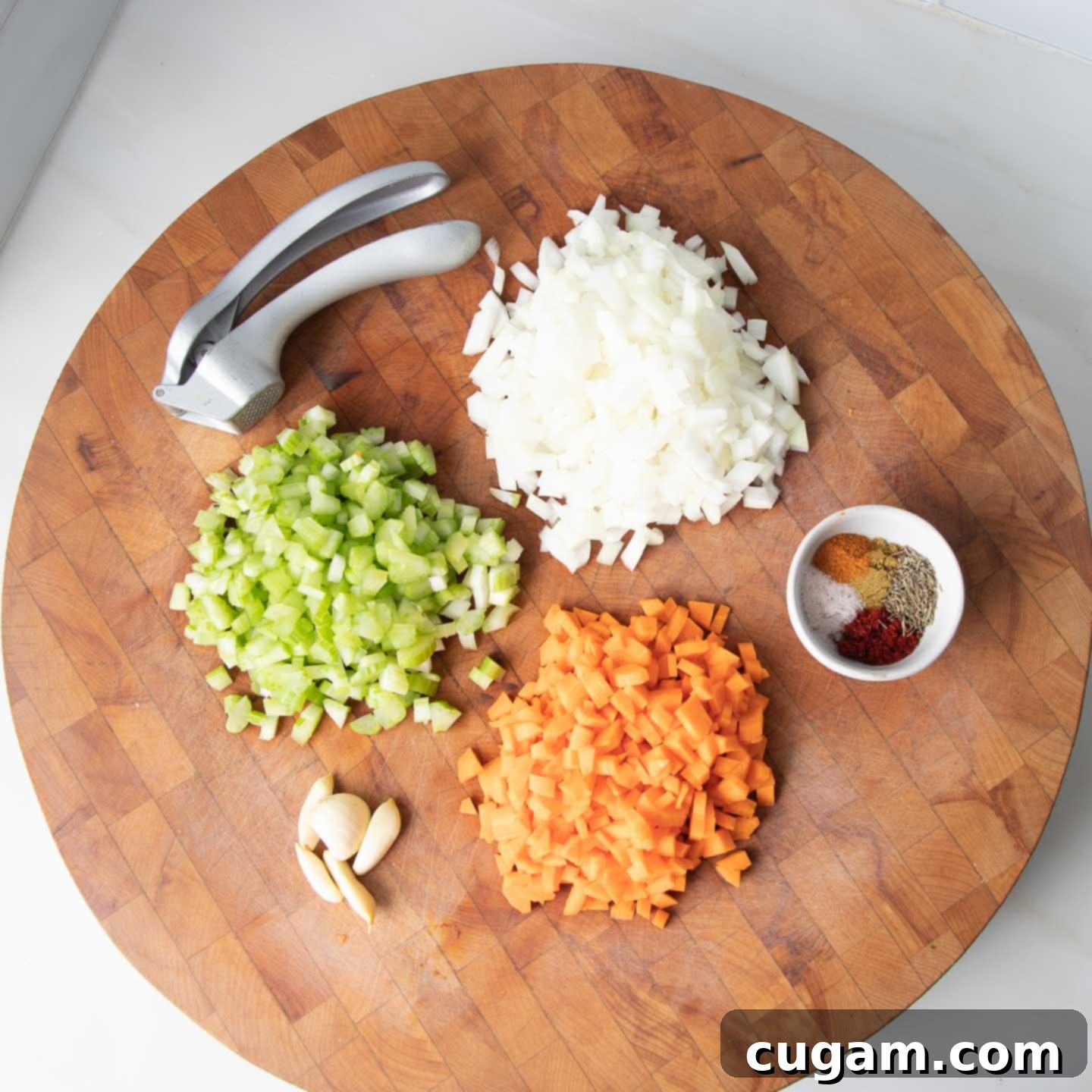
Step 1: Prepare Your Aromatics. Begin by dicing your onions, celery, and carrots into small, uniform pieces. This ensures they cook evenly and integrate seamlessly into the meatloaf mixture. Press the garlic cloves and measure out all your spices, having everything ready for the sautéing process.
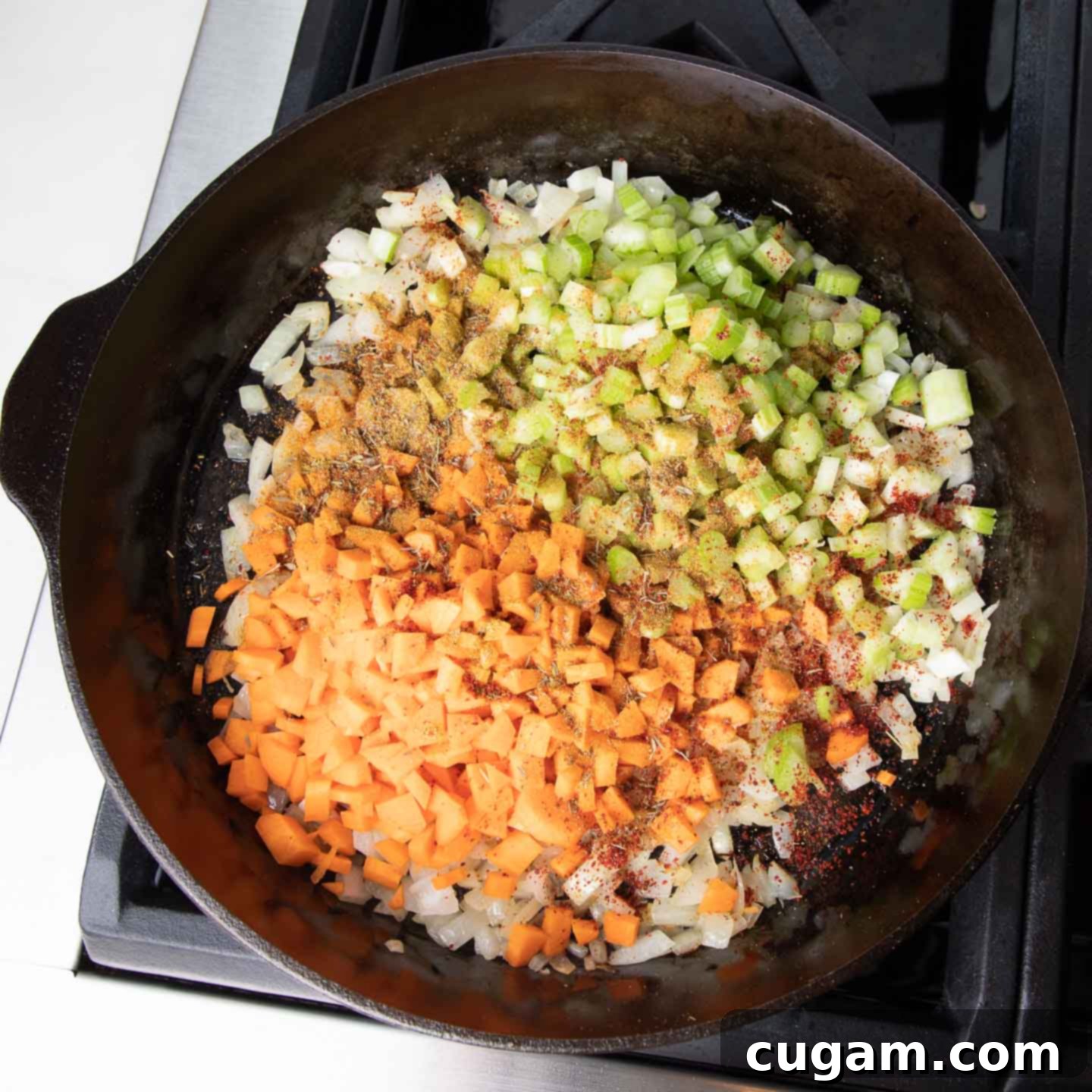
Step 2: Sauté the Veggies and Spices. Heat a heavy skillet over medium heat. Add your diced onions, carrots, celery, and all the measured spices. Sauté for about 5 minutes, stirring occasionally, until the vegetables begin to soften and become tender. Then, add the pressed garlic and cook for another minute, stirring constantly to release its aroma without burning.
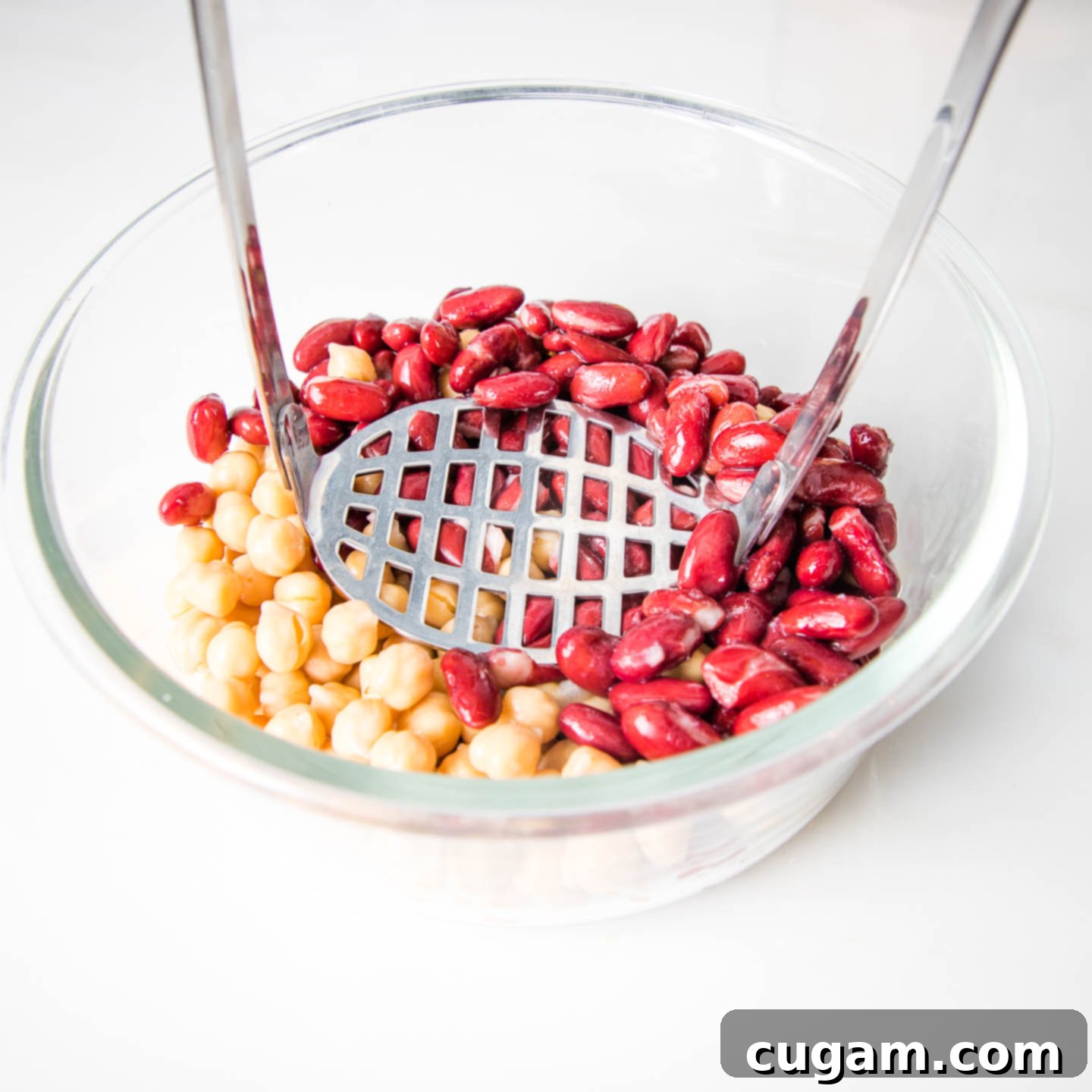
Step 3: Prepare the Beans. While your vegetables are sautéing, thoroughly rinse and drain your kidney beans and chickpeas. Transfer the clean beans to a large mixing bowl, preparing them for the mashing process.
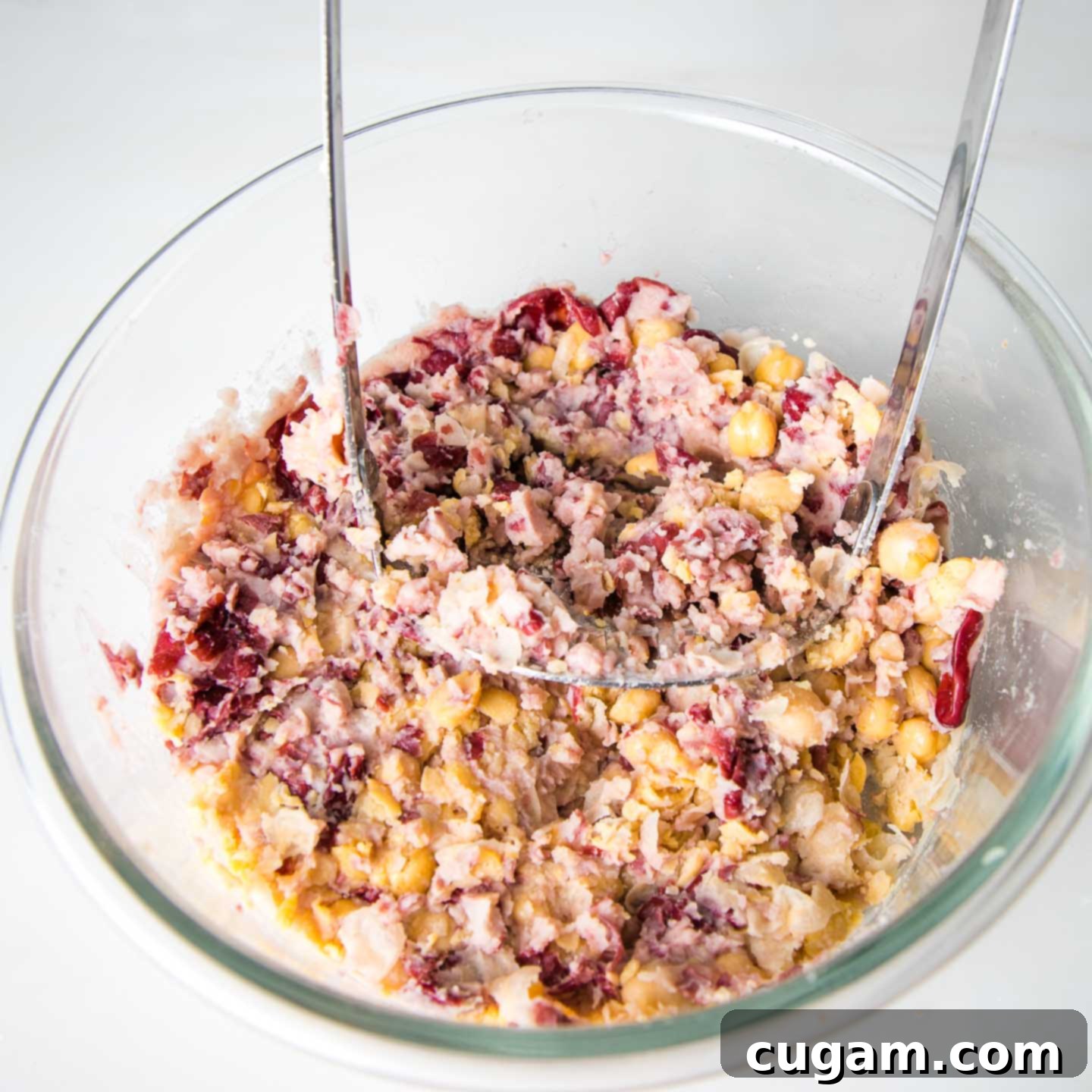
Step 4: Mash the Beans. Using a sturdy potato masher or a large fork, mash the beans in the mixing bowl. Aim for a consistency that is mostly mashed but still contains some discernible chunks, as this will contribute to the meatloaf’s satisfying texture.
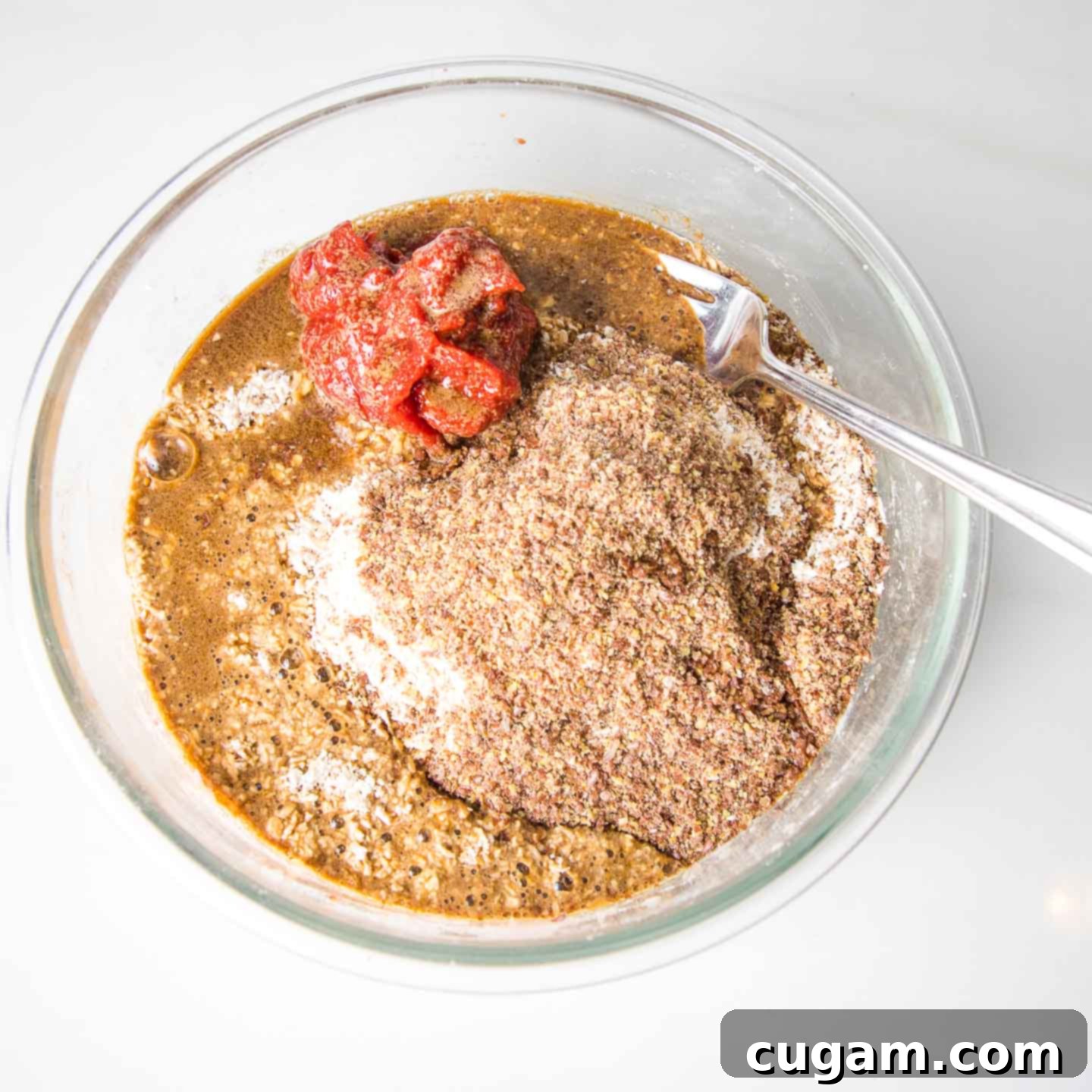
Step 5: Combine Wet and Dry Binders. To the mashed beans, add the almond milk, vegan Worcestershire sauce, tamari, tomato paste, ground oats, and ground flax seeds. Mix all these ingredients thoroughly with a fork until they are completely incorporated and a cohesive “dough” begins to form. This step is crucial for the meatloaf’s structure and moistness.
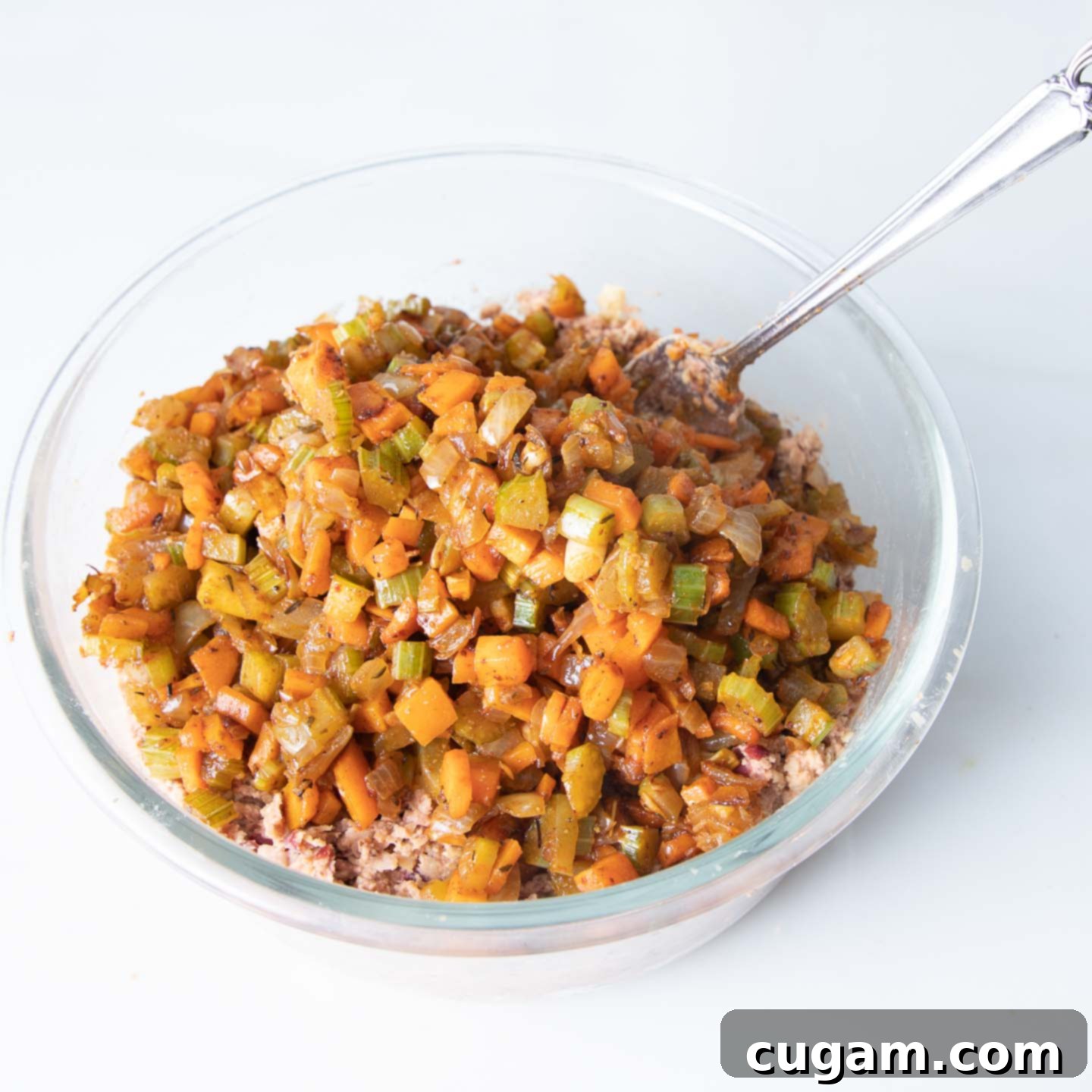
Step 6: Integrate Sautéed Vegetables. Add the cooled sautéed vegetable mixture from Step 2 into the bowl with the bean mixture. Mix thoroughly until the vegetables are evenly distributed throughout the plant-based “meatloaf” base. Ensure everything is well combined.
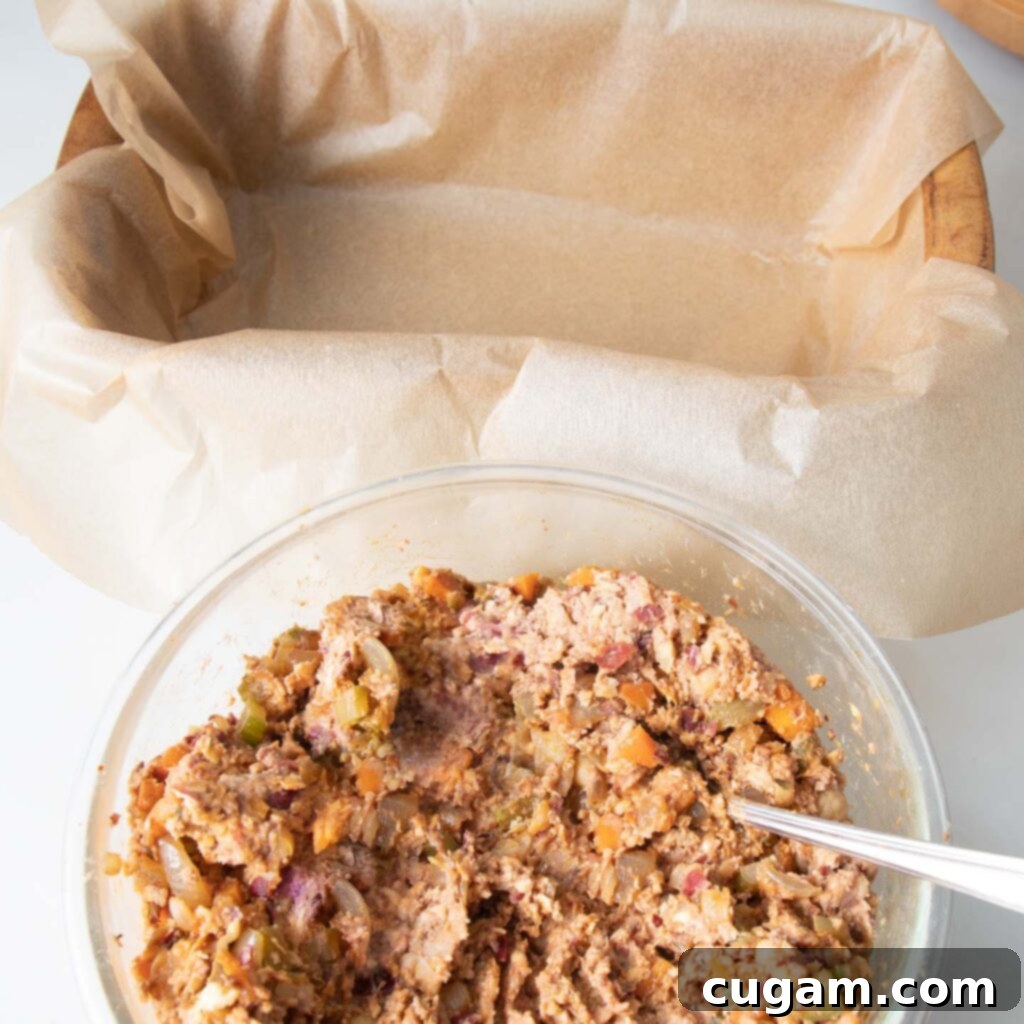
Step 7: Fill and Compress the Loaf Pan. Ensure your loaf pan is lined with unbleached parchment paper. Spoon the bean mixture into the prepared loaf pan, pressing it down firmly with an offset spatula or the back of a spoon. This compression is vital to eliminate air pockets and ensure your meatloaf holds its shape beautifully. Bake in the preheated 375°F (190°C) oven for 30 minutes.
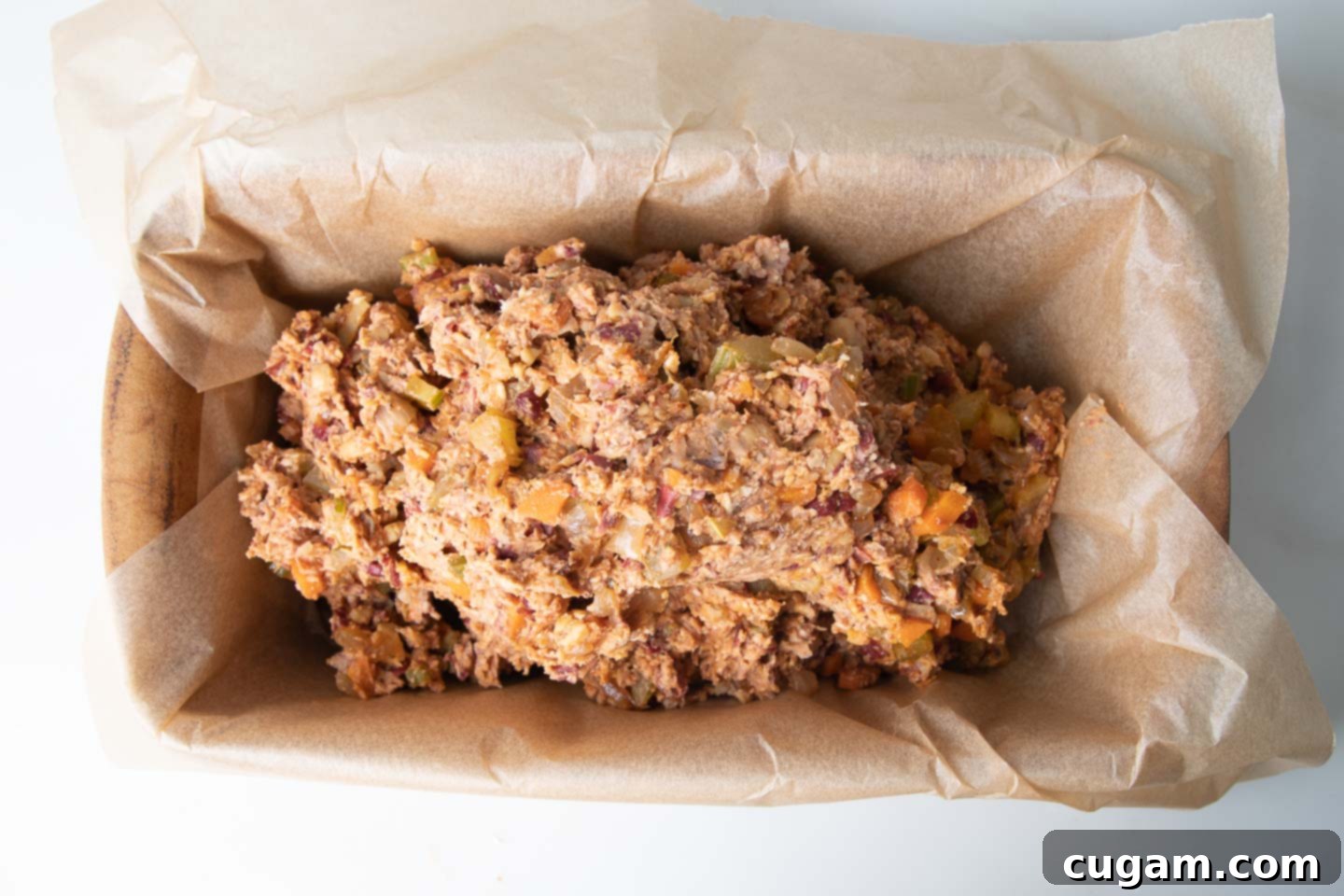
Step 8: Spoon and Distribute. Carefully spoon the entire bean mixture into your prepared loaf pan, ensuring an even distribution across the bottom.
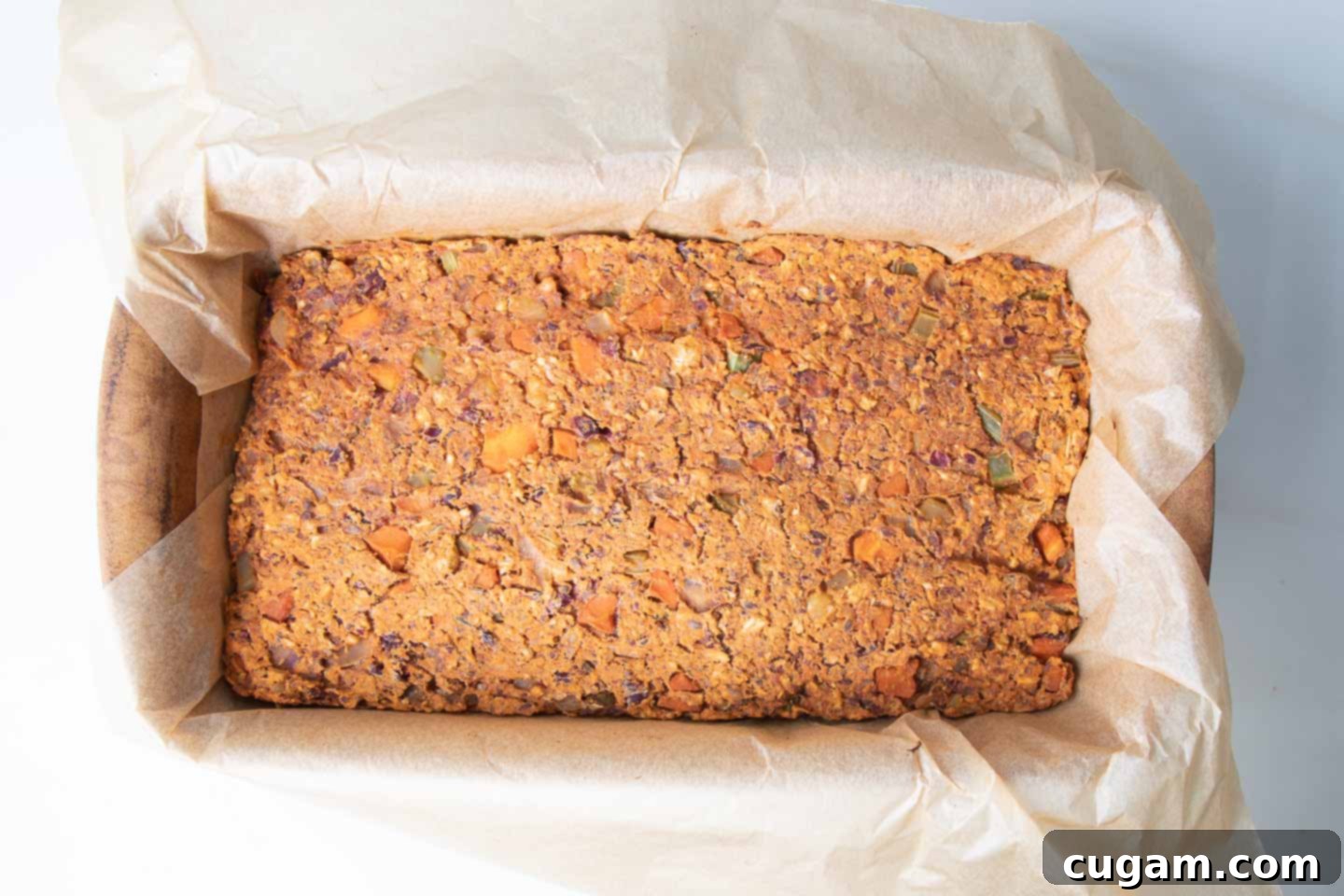
Step 9: Smooth and Bake. Use an offset spatula or the back of a spoon to firmly smooth and compress the mixture, removing any air pockets. Bake in the preheated 375°F (190°C) oven for an initial 30 minutes.
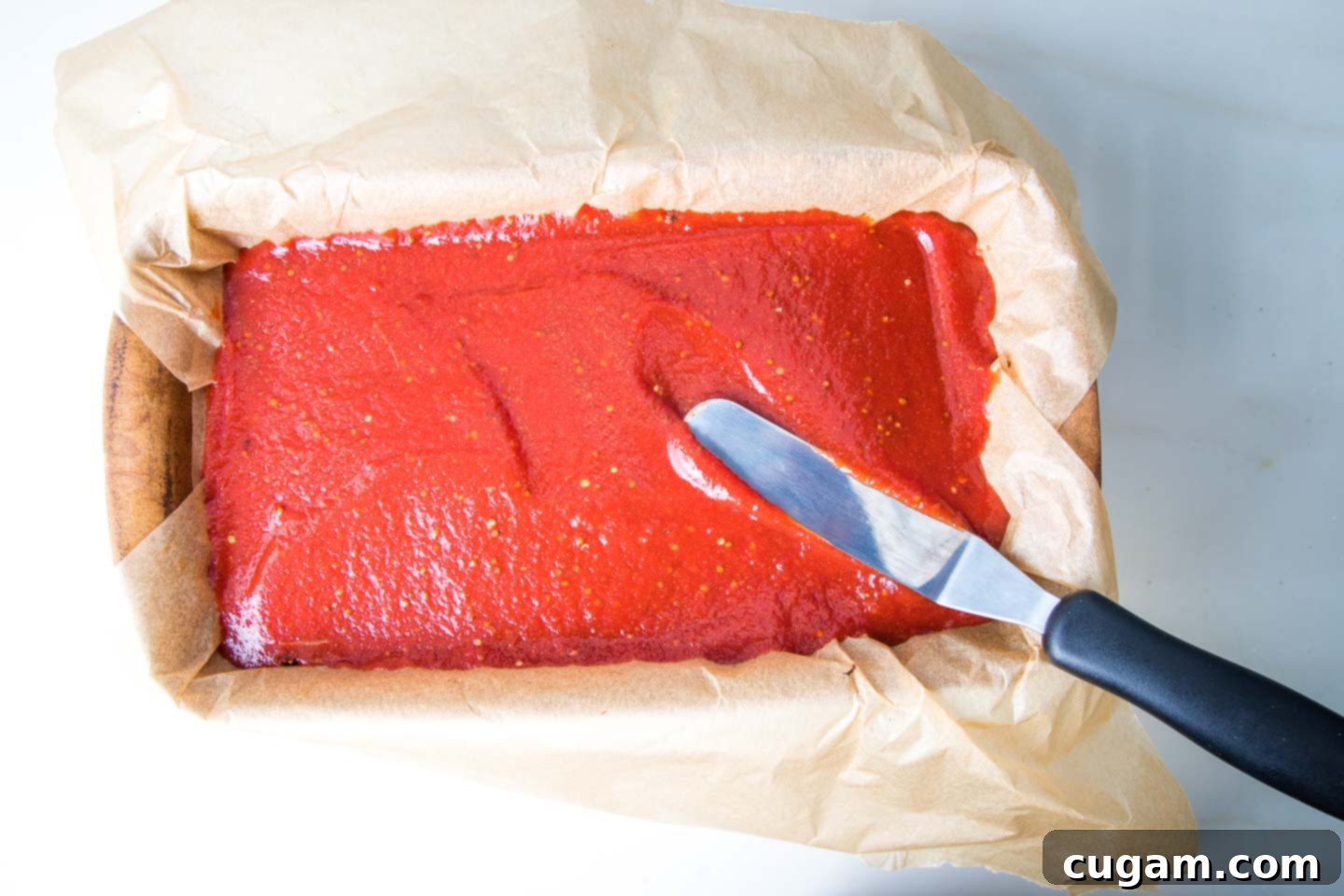
Step 10: Prepare and Apply the Glaze. While the meatloaf bakes, prepare the mouth-watering glaze. In a small bowl, whisk together the tomato paste, apple cider vinegar, maple syrup, whole grain mustard, salt, and pepper until smooth. After the initial 30 minutes of baking, remove the meatloaf from the oven and use your offset spatula to spread this flavorful glaze evenly over the top of the partially baked bean mixture.
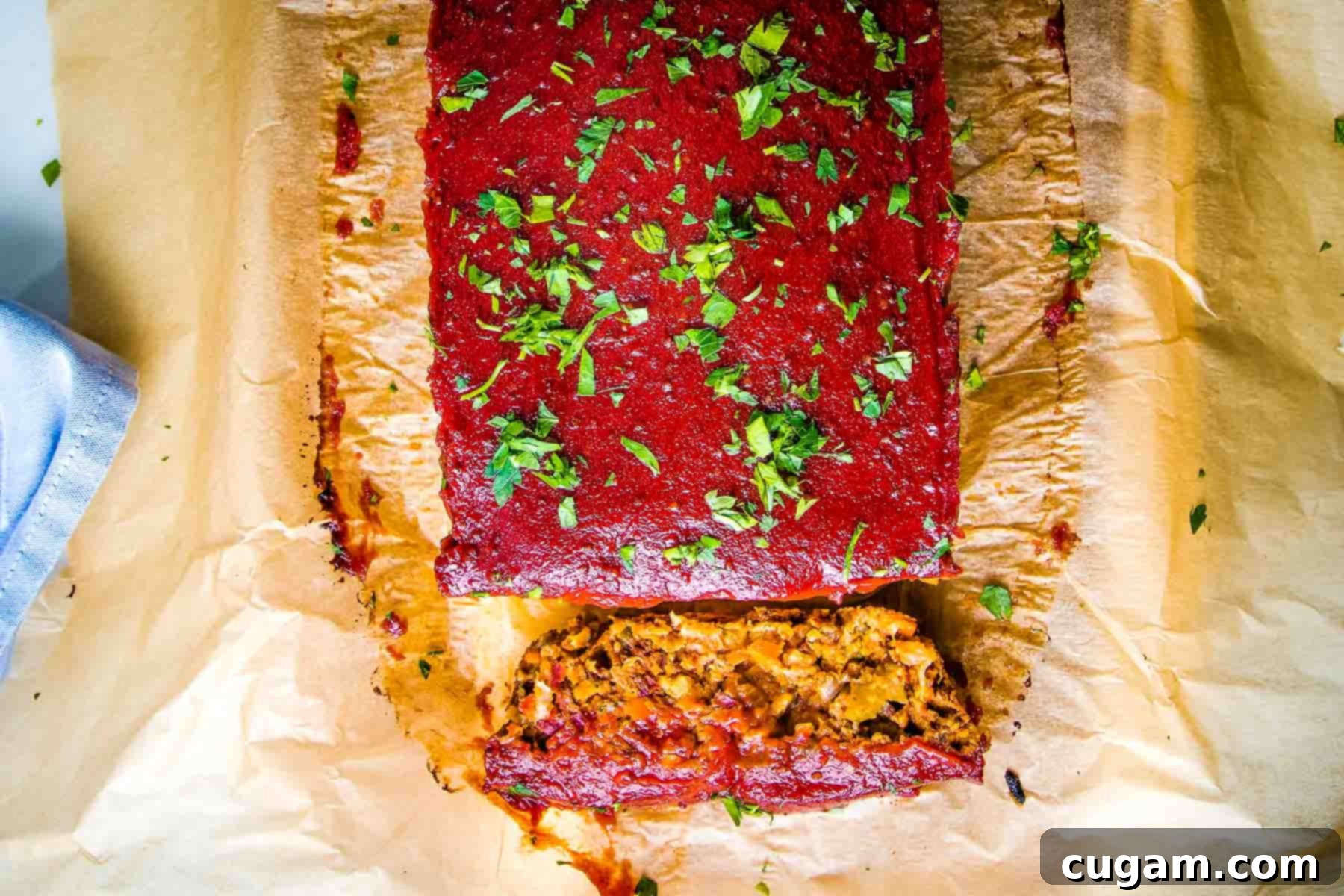
Step 11: Final Bake, Cool, and Serve. Return the glazed meatloaf to the oven and bake for an additional 25 minutes, allowing the glaze to caramelize beautifully. Once baked, remove it from the oven and let it cool in the pan for at least 10 minutes. This cooling period is crucial for the meatloaf to set and ensures clean slices. Then, carefully lift the parchment paper to remove the entire loaf. Sprinkle with fresh chopped herbs like parsley or cilantro for a burst of color and flavor, slice, and serve your perfectly prepared vegan meatloaf.
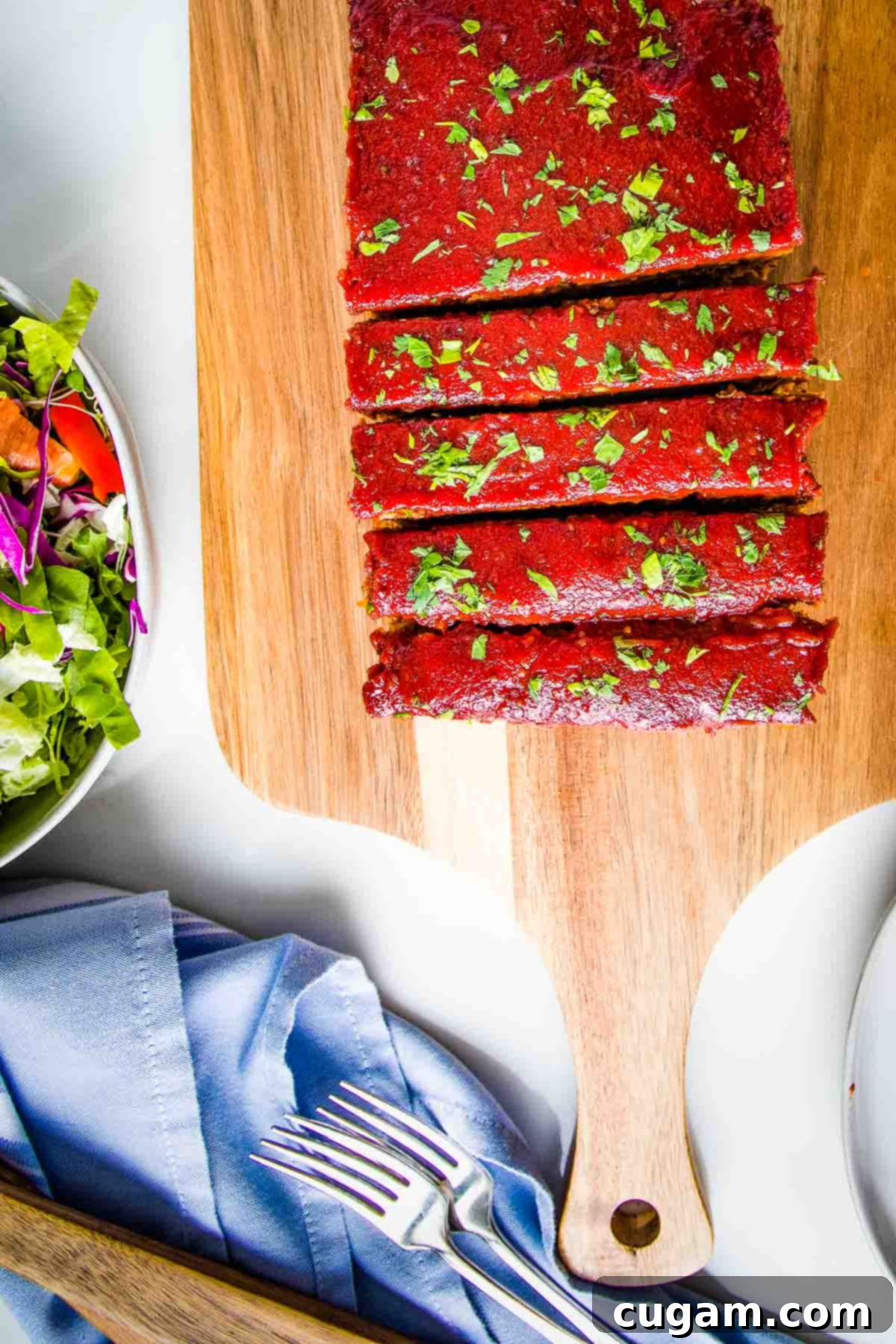
Meal Prep and Storage for Your Vegan Meatloaf
This vegan meatloaf is not only delicious but also incredibly versatile for meal prepping, ensuring you can enjoy its comforting flavors throughout the week or even months later. Here’s how to maximize its shelf life and convenience:
- Make Ahead (Unbaked): Prepare the meatloaf batter completely, up to the point of pressing it into the loaf pan. Cover the pan tightly with plastic wrap or foil. It can be stored in the fridge for up to 3 days, or in the freezer for up to 3 months. If freezing, make sure to let it defrost in the fridge overnight before baking. Bring it to room temperature before placing it in the oven for best results.
- Make Ahead (Baked): You can also bake the entire meatloaf, including the glaze, ahead of time. Once it has cooled completely, follow the storage and reheating directions below. This is perfect for busy schedules!
- Storage (Cooked): Once cooked and cooled, slice any remaining meatloaf and store it in an airtight container in the fridge for up to 5 days. A glass loaf pan with a lid is ideal for both baking and storing, minimizing extra dishes.
- Freezing (Cooked): For longer storage, cooked meatloaf freezes beautifully. Wrap individual slices or the entire cooled loaf tightly in plastic wrap, then place in an airtight freezer-safe container or bag. It can be frozen for up to 3 months. Defrost overnight in the fridge before reheating.
- Reheating: To reheat already cooked meatloaf, place slices in a preheated oven at 350°F (175°C) for about 20-25 minutes, or until warmed through. You can also gently reheat individual slices in a microwave, though the oven will help maintain a crispier exterior. If reheating a defrosted, uncooked loaf, follow the full baking instructions from the recipe card, including adding the glaze at the appropriate time.
Debra’s Pro Tips for the Best Vegan Meatloaf
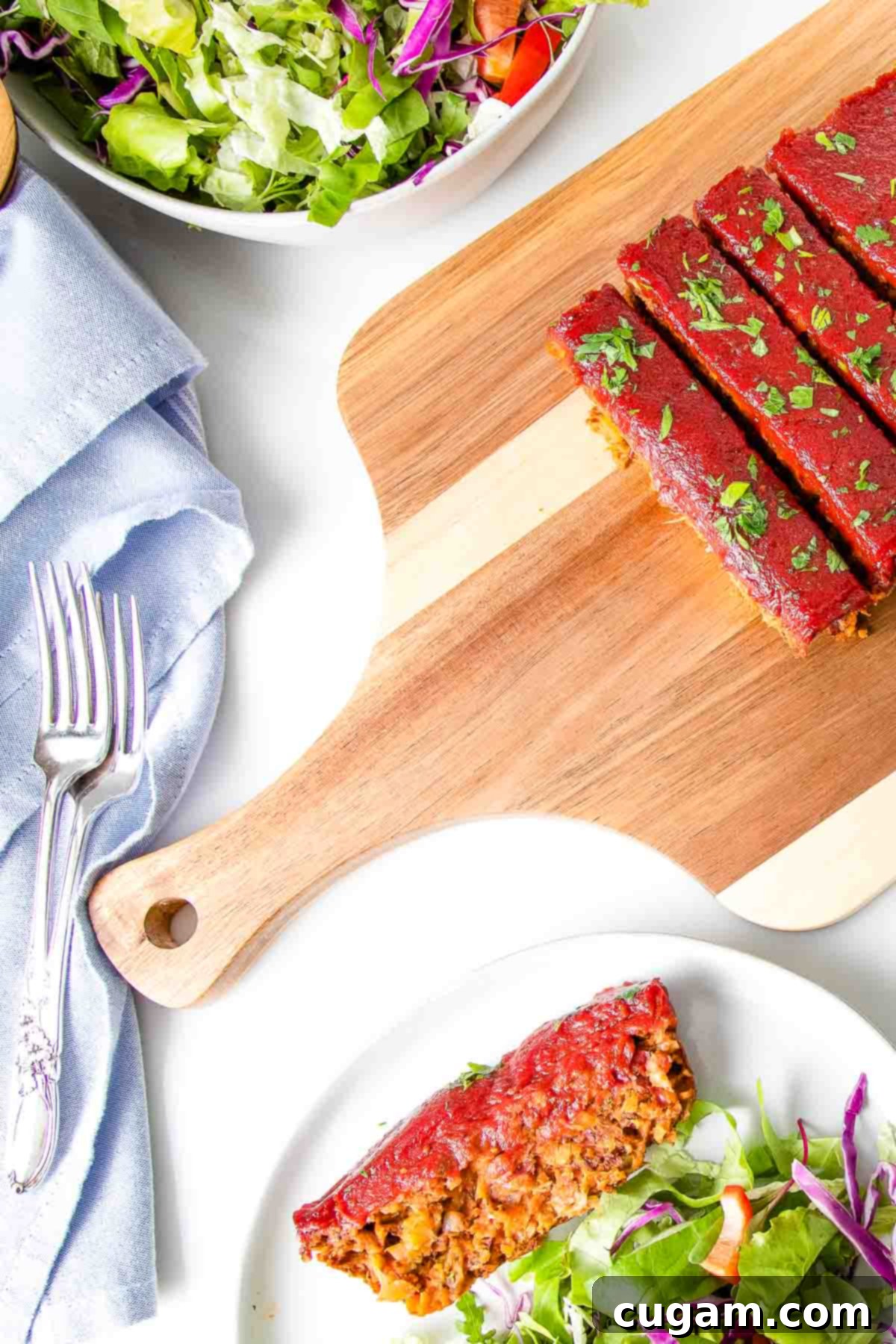
- Bean Selection for Optimal Texture: While any combination of two 14.5-oz cans (or 3 cups cooked) of beans will work, using both chickpeas and kidney beans creates a fantastic balance. Chickpeas offer a slightly firmer bite, while kidney beans contribute a rich color and creaminess, together mimicking the varied texture of ground meat. You can also explore using pinto beans, great northern beans, or even black beans for a deeper hue and different flavor profile.
- Mastering the Mash: When mashing your beans, don’t aim for a completely smooth paste. The secret to a perfect vegan meatloaf texture is to leave some beans partially mashed, creating small chunks. This variety in texture will give your finished meatloaf a more substantial and satisfying bite, reminiscent of traditional meatloaf.
- Glaze Alternatives: While the homemade tomato glaze is undeniably delicious, if you prefer a different flavor profile or simply aren’t a fan of tomato-based toppings, consider topping your meatloaf with a batch of my easy vegan gravy instead. It adds a rich, savory depth that is equally comforting and pairs wonderfully with the robust flavors of the meatloaf.
- Parchment Paper is Your Best Friend: For effortless removal and minimal cleanup, always line your loaf pan with unbleached parchment paper. Leave an overhang on the sides so you can easily lift the entire meatloaf out of the pan once it’s cooked and cooled, preventing any sticking.
- The Importance of Cooling: Patience is a virtue, especially when it comes to slicing meatloaf. Allow your vegan meatloaf to cool in the pan for at least 10-15 minutes after baking. This crucial resting period allows the binders to fully set and the internal structure to firm up, ensuring that you get clean, beautiful slices every time, rather than a crumbly mess.
What to Serve with Your Wholesome Vegan Meatloaf
A perfectly crafted vegan meatloaf deserves equally delicious side dishes to complete the meal. These pairings are designed to complement the rich, savory flavors of the meatloaf, creating a balanced and utterly satisfying dining experience. Here are some of my favorite recommendations:
- Dairy-free Garlic Mashed Potatoes
- Easy Green Salad Recipe with Capers
- Easy Recipe for Green Beans with Almonds
- Oven Roasted Crispy Broccoli
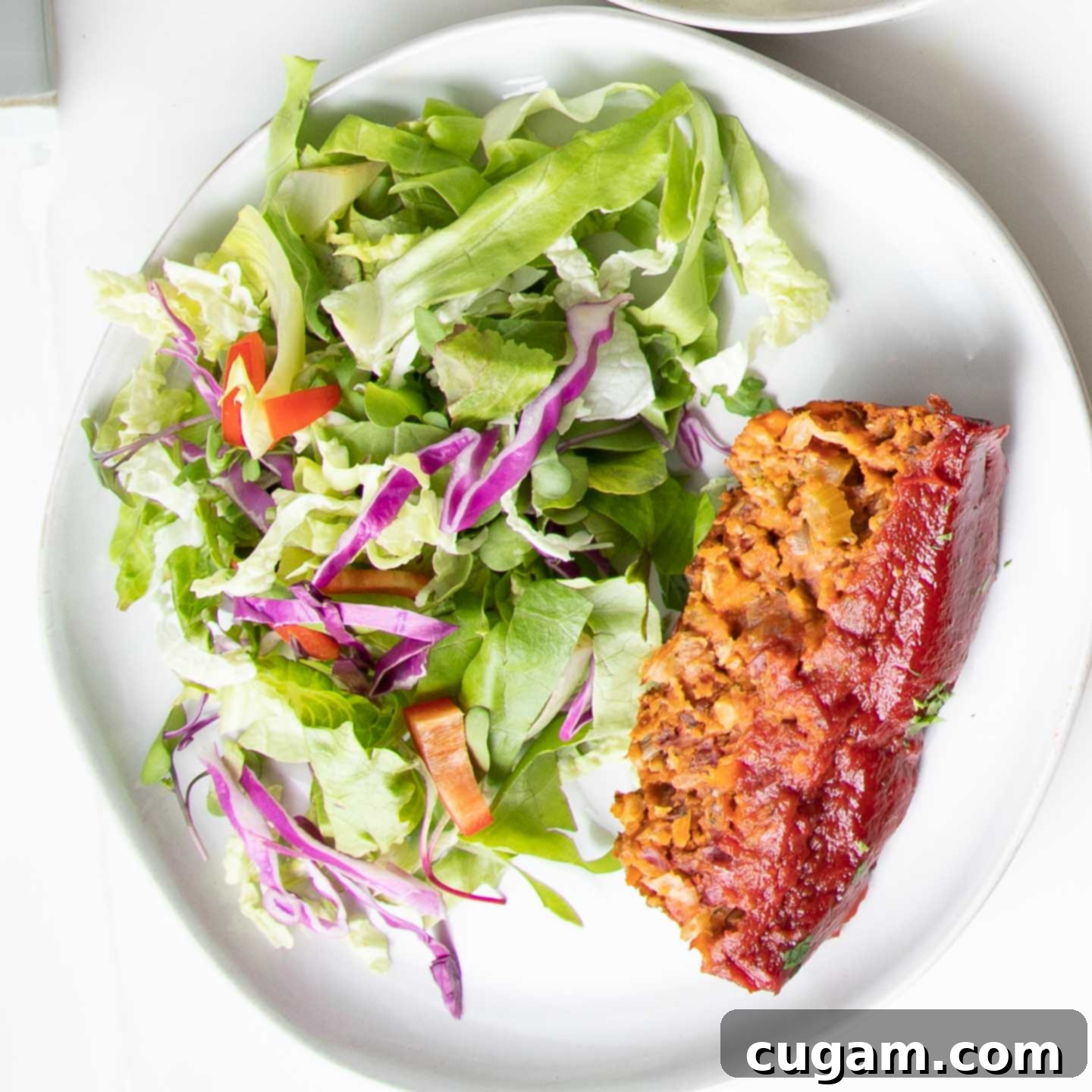
Frequently Asked Questions (FAQs) About Vegan Meatloaf
Vegan meatloaf is creatively crafted using plant-based ingredients to mimic the texture and savory flavor of traditional meatloaf. Common primary ingredients include mashed beans (like kidney, black, or pinto beans), lentils, crumbled tofu, or seitan, all of which provide a hearty base and protein. These are often combined with grains such as cooked brown rice or quinoa, and binders like ground oats or flaxseed, along with sautéed aromatic vegetables and a rich blend of spices to create a delicious and wholesome plant-based protein.
If you’re looking for alternatives to breadcrumbs in meatloaf, especially for a gluten-free or healthier option, there are several excellent choices that provide great binding and texture. Rolled oats, or finely ground oats (which can be made by blending regular rolled oats), are fantastic. Other options include crushed gluten-free crackers, finely crushed plain potato chips, or even cooked quinoa. These ingredients absorb moisture and help hold the meatloaf together, contributing to a firm yet tender consistency.
No, an egg is not a strictly necessary ingredient in meatloaf, especially when making a vegan version. While eggs traditionally serve as a binder, there are many effective plant-based alternatives that can achieve the same cohesive result. In this recipe, ground flaxseed mixed with water (often called a “flax egg”) is used as a powerful vegan binder. It not only helps hold the meatloaf together beautifully but also contributes beneficial omega-3 fatty acids and dietary fiber, enhancing the nutritional profile of the dish.
Did you know commenting and rating recipes is one of the best ways to support your favorite food bloggers? If you made this recipe, please consider leaving a five-star rating below and a comment sharing your experience. Also, we’d love to see your creations! Please share your photos on Instagram by tagging me @dkhealthcoach and using the hashtag #debraklein. Your feedback and shares truly help our community grow!
📖 Recipe
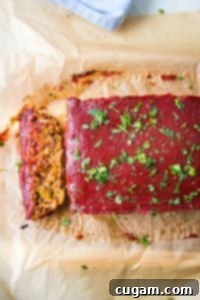
Vegan Meatloaf Recipe
Rate this Recipe
Pin Recipe
Equipment
-
Parchment Baking Paper
-
Potato Masher
-
Glass Loaf Pan with Cover
-
Offset spatula
Ingredients
Meatloaf
- 1 medium yellow onion small dice
- 3 carrots small dice
- 2 stalks celery small dice
- 1 teaspoon paprika
- 1 teaspoon cumin
- ½ teaspoon thyme
- ½ teaspoon coarse sea salt
- ¼ teaspoon cayenne pepper
- 4 cloves garlic pressed
- 1 14.5-oz can kidney beans rinsed and drained
- 1 14.5-oz can chickpeas rinsed and drained
- ¼ cup almond milk
- 3 Tablespoons vegan Worcestershire sauce
- 1 Tablespoon Tamari
- 3 Tablespoons tomato paste
- 1 cup ground oats
- 3 Tablespoons ground flax seeds
Glaze
- ½ cup tomato paste
- ¼ cup apple cider vinegar
- 3 Tablespoons maple syrup
- 2 teaspoons whole grain dijon mustard
- ½ teaspoon coarse sea salt
- ½ teaspoon white pepper
Instructions
-
Preheat oven to 375°F (190°C) and line a standard loaf pan with unbleached parchment paper, ensuring it overhangs the sides for easy removal.
-
Heat a large skillet over medium heat. Add your diced onion and sauté for about 2 minutes. Use a splash of water, veggie broth, or olive oil to sauté, depending on your dietary preferences. Add the carrots, celery, paprika, cumin, thyme, salt, and cayenne pepper, and continue to cook, stirring occasionally, until the vegetables are tender, approximately 5 minutes. Stir in the pressed garlic and cook for just 1 minute more, stirring constantly to prevent burning and release its fragrant aroma.
-
In a large mixing bowl, use a potato masher or a fork to mash the rinsed and drained kidney beans and chickpeas. Aim for a consistency that is mostly mashed but still retains some small chunks for varied texture. Stir in the almond milk, vegan Worcestershire sauce, tamari, tomato paste, ground oats, and ground flax seeds. Mix everything well until thoroughly combined and sticky. Then, incorporate the cooked vegetable mixture into the bean mixture, stirring until fully integrated.
-
Spoon the meatloaf mixture firmly into the prepared loaf pan. Use an offset spatula or the back of a spoon to press down and smooth the top, ensuring there are no air pockets. Bake in the preheated oven for 30 minutes.
-
While the meatloaf is undergoing its initial bake, prepare the delicious glaze. In a small bowl, whisk together the tomato paste, apple cider vinegar, maple syrup, whole grain Dijon mustard, salt, and white pepper until smooth. Set aside.
-
After the initial 30 minutes of baking, remove the meatloaf from the oven. Evenly spoon the prepared glaze over the top and spread it gently with an offset spatula. Return the meatloaf to the oven and bake for an additional 25 minutes, allowing the glaze to set and lightly caramelize.
-
Once baked, remove the meatloaf from the oven and allow it to cool in the pan for at least 10 minutes. This resting period is crucial for the meatloaf to firm up, making it easier to slice cleanly. After cooling, gently lift the parchment paper to remove the entire meatloaf from the pan.
-
For an extra touch of freshness and color, sprinkle chopped fresh parsley or cilantro over the top before slicing and serving. Enjoy your hearty and delicious vegan meatloaf!
Notes
Milk: If you have nut allergies, or simply prefer a different plant-based milk, you can easily substitute almond milk with soy milk or oat milk. Ensure it’s unsweetened and unflavored to maintain the savory profile of the meatloaf.
Oats: For a grain-free vegan meatloaf, you can substitute the ground oats with almond flour or additional ground flax seeds. Adjust the amount as needed to achieve a firm, bindable consistency, as different binders may absorb moisture differently.
This meatloaf is excellent for making in advance! You can prepare the mixture up to Step 4. Store the uncooked loaf in the fridge for up to 3 days, or freeze it for up to 3 months. Remember to bring it to room temperature before baking to ensure even cooking.
Nutrition
Note
The nutrition calculations were done using online tools. To obtain the most accurate representation of the nutritional information in any given recipe, you should calculate the nutritional information with the actual ingredients you used. You are ultimately responsible for ensuring that any nutritional information is accurate, complete and useful.
